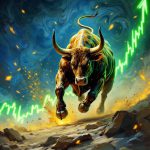
The Wolves of Market Chaos: Exploiting Fear and Mastering the Bitcoin 200 Day Moving Average
Apr 7, 2025
The market doesn’t crash—it implodes. Fear detonates like a bomb, obliterating logic, trust, and wealth in seconds. It’s not a slow-motion descent; it’s a cascading freefall, a chain reaction triggered by panic. The herd doesn’t think—it reacts. One sell order becomes ten, then a hundred, then a thousand. Fear spreads like wildfire, fueled by headlines, whispers, and the primal instinct to flee. You’ve seen it: the 2008 financial collapse, the dot-com bubble bursting, the COVID-19 selloff. These weren’t just market corrections; they were psychological breakdowns.
Here’s the truth no one wants to admit: fear destroys wealth, but it also creates it. For every investor selling at the bottom, there’s a wolf buying at a discount. For every panicked retreat, there’s someone stepping forward—not blindly, but with precision, clarity, and strategy. The herd runs from fire; the wolves move toward it. If you want to survive, if you want to thrive, you need to understand this: chaos isn’t your enemy. It’s your opportunity. And tools like the bitcoin 200 day moving average are your weapon in this war.
The Anatomy of Panic: Fear’s Neurochemical Grip on Markets
Panic isn’t born of logic—it’s a chemical hijacking. When markets turn red, your brain doesn’t evaluate probabilities or risk-reward ratios. The amygdala takes over, flooding your body with cortisol and adrenaline. This fight-or-flight response was designed to save you from predators, not portfolio losses. And yet, in the chaos of a market selloff, it’s what drives most investors to sell at the worst possible time.
The mechanism is simple: fear spreads through mirror neurons. One trader panics and sells. Others see it and do the same. It’s a feedback loop, a self-reinforcing cycle that turns a minor correction into a full-blown crash. Cognitive dissonance amplifies the pain. Investors who’ve held onto losing positions can’t reconcile their hope for recovery with the reality of falling prices. The result? A stampede.
Consider the carnage of 2008. As the housing bubble burst, financial institutions collapsed, and the S&P 500 lost over 50% of its value, fear ruled. Investors dumped assets at fire-sale prices, convinced the world was ending. But it wasn’t. The wolves—those who saw beyond the panic—stepped in. They bought when others sold. They understood that fear wasn’t a signal to run; it was an opportunity to act.
The same dynamic played out during the COVID-19 crash in March 2020. The VIX, the market’s “fear gauge,” hit record highs as investors fled to cash. But for those who understood the tools of technical analysis, including the bitcoin 200 day moving average, it was a moment of clarity. They saw oversold conditions, ignored the noise, and positioned themselves for the eventual recovery. The lesson? Fear is predictable. And if it’s predictable, it’s exploitable.
The Wolves Move Different: Decoding the Contrarian Mindset
Herds panic. Wolves calculate. This isn’t just a metaphor—it’s a survival strategy. Legendary traders like Jesse Livermore didn’t follow the crowd; they studied it. They understood that markets are driven by emotion, not logic, and they positioned themselves to profit when fear took hold. Livermore famously shorted the market during the 1929 crash, turning chaos into one of the greatest trades in history.
Sir John Templeton mastered a different kind of contrarianism. In 1939, as World War II loomed, he borrowed money to buy shares in every company trading under $1 on the New York Stock Exchange. The herd was convinced the world was ending. Templeton saw an opportunity. By the time the war ended, his investments had multiplied many times over. Fear blinded the herd, but it sharpened his vision.
In today’s markets, contrarians like Ray Dalio operate with the same mindset. Dalio’s approach is rooted in systems thinking—understanding how interconnected forces amplify or dampen market moves. He doesn’t react to fear; he calculates its impact, hedges against its extremes, and positions Bridgewater to profit from volatility. His mantra, “Pain + Reflection = Progress,” is a reminder that discomfort is a teacher, not an obstacle.
Modern contrarians aren’t limited to equities. They operate in the shadows of cryptocurrency markets, where tools like the bitcoin 200 day moving average help them identify trends and exploit emotional overreactions. They don’t chase hype—they dissect it, looking for cracks in the narrative where opportunity hides.
Fear as Fuel: Strategic Options Play
When fear consumes the market, volatility spikes. Option premiums inflate, creating opportunities for those bold enough to act. One of the most effective strategies in these moments is selling puts during VIX spikes.
Here’s how it works: When fear drives the VIX higher, put options become more expensive. By selling these puts, you collect the inflated premium, effectively betting that the underlying stock won’t fall below the strike price. If the stock stays above the strike, you pocket the premium as profit. If it falls, you acquire the stock at a discount—essentially buying it on sale while being paid to wait.
But this strategy doesn’t stop there. Savvy traders reinvest these premiums into LEAPS (Long-Term Equity Anticipation Securities)—long-dated call options that provide leveraged exposure to a stock’s recovery. This creates a compounding effect, turning short-term fear into long-term profit. It’s a strategy of calculated aggression, built from the very volatility that terrifies the herd.
During the COVID-19 crash, this approach paid off massively. As the VIX hit historic highs, contrarians sold puts on oversold stocks while reinvesting the premiums into LEAPS. When the market rebounded, their positions exploded in value. This isn’t theory—it’s execution. It’s a blood-on-the-floor opportunity, seized by those who understood that fear isn’t the end. It’s the beginning.
Calculated Aggression: Risk as a Weapon
Let’s be clear: this isn’t gambling. It’s war. And in war, risk isn’t something to fear—it’s a weapon to wield. The difference between reckless trading and calculated aggression is discipline. Recklessness is YOLO. Discipline is knowing your edge, defining your risk, and executing with precision.
Start with position sizing. Never bet more than you can afford to lose. Define your maximum acceptable loss on every trade, and stick to it. Use stop-loss orders to protect your downside, and don’t let emotions override your plan. This isn’t about chasing gains—it’s about controlling losses.
Next, develop a playbook for different market conditions. When fear drives volatility higher, sell puts. When trends emerge, use tools like the bitcoin 200 day moving average to confirm your entry points. When uncertainty reigns, hedge your positions with uncorrelated assets. This isn’t guesswork—it’s strategy, designed to maximize reward while minimizing risk.
Finally, cultivate emotional discipline. Fear and greed are the twin forces that drive markets, but they’re also your greatest enemies. Study them. Understand how they influence your decisions. And when panic grips the market, remember this: the herd reacts, but the wolves calculate.
The Exit Velocity of Independence
This isn’t just about money. It’s about freedom. Escaping the herd isn’t a financial decision—it’s a psychological one. It’s about breaking free from the mental prison of fear, reclaiming your autonomy, and learning to think independently in a world that rewards conformity.
When you master the tools of contrarian investing—when you learn to exploit fear, calculate risk, and act with precision—you gain more than financial success. You gain power: power over your emotions, power over the noise, and power over the system itself. This is the ultimate reward: not just wealth, but autonomy.
The next time fear grips the market, ask yourself: will you run with the herd, or will you move like a wolf? The choice is yours. Make it wisely.














